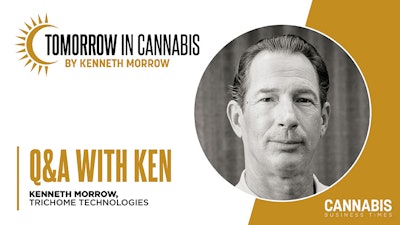
Question: I remember many years ago, you wrote that you were not necessarily in favor of vertical horticulture at commercial scale. I'm currently designing a cultivation area for a facility with very high ceilings, and I'm wondering: Have your thoughts on the matter evolved over the years?
Answer: That opinion was informed by the large-scale cannabis production equipment and technology available at the time. Today, my view is completely the opposite because of the equipment and technology available.
At the time, the only real commercial-scale vertical agriculture was predominantly focused on growing short crops, such as herbs, lettuce, or microgreens. Those facilities typically utilized custom-fabricated shelving or metal racks to facilitate growing on multiple levels, which maximized floor space many times over. These racks, and all the ancillary equipment required to maximize worker productivity and plant growth, were very expensive to build.
Today, there have been significant investments into both equipment and technology available to grow taller and bigger cannabis crops. Many multitiered, purpose-built rack systems are now readily available in many configurations, some as tall as five or more tiers. Along with these purpose-built systems, there is a plethora of ancillary accoutrements available that are designed for use in vertical horticulture applications, including lighting, irrigation, and ventilation systems.
Purpose-built and custom-designed ventilation systems, HVAC, dehumidification, and CO2 controls exist today. These facilitate even airflow between tiers, ensuring that the bottom and top tier environments are identical and consistent when it comes to airflow speed, air velocity, and humidity (and thus VPD), all while mitigating the possibilities of hot spots or stagnant air.
Many of these purpose-built systems have also been tested out in practice. For example, in the early days of legalized cannabis cultivation, a grower would need to figure out the different fertigation pump size requirements between the first, second, third, and fourth tiers as the “head height” capabilities (the height a pump can lift a fluid, overcoming gravity) of pumps were different.
Today, there are complete fertigation systems available that ensure even nutrient and water applications at each tier, simplifying a facility designer’s and grower’s work.
Additionally, when I wrote my original opinion, lighting fixtures were archaic when compared with current offerings. HID lighting fixtures, be it metal halide or sodium halide, were the dominant forms of commercial-scale lighting for indoor cannabis production. These lights produced a lot of heat, which forced growers to increase the space between tiers as the closer the light source, the higher the radiant temperature and leaf surface temperatures.
Today’s LEDs are very refined with respect to spectrum, intensity, and operating temperature. LED lighting produces less heat and facilitates the tiers being closer together, in turn allowing growers to pack more tiers in the same space compared to HIDs.
Besides the advancements in horticultural systems and equipment, there is more funding available today for the utilization of very expensive ancillary equipment necessary to efficiently manage a multitier vertical grow. For instance, to best utilize a multitier system on a large scale, growers require multiple scissor lifts to enable staff access to higher tiers for plant and system maintenance and installation, and to harvest. Very convenient and efficient netting support systems also exist to incorporate into the modern multitier systems. These enable staff to easily reinstall new netting between harvests.
Given the equipment and technology available today, there is no reason not to explore the possibilities of vertical growing – if you have the available space.
Kenneth Morrow is an award-winning grower and breeder. He is the owner of Trichome Technologies, a research and development company. He is also a consultant and author of the book "Marijuana Horticulture Fundamentals" and a founding advisory board member of Cannabis Business Times, where he has been a columnist since 2015. Find him on Instagram @trichometechnologies or reach him via email at: [email protected].



























